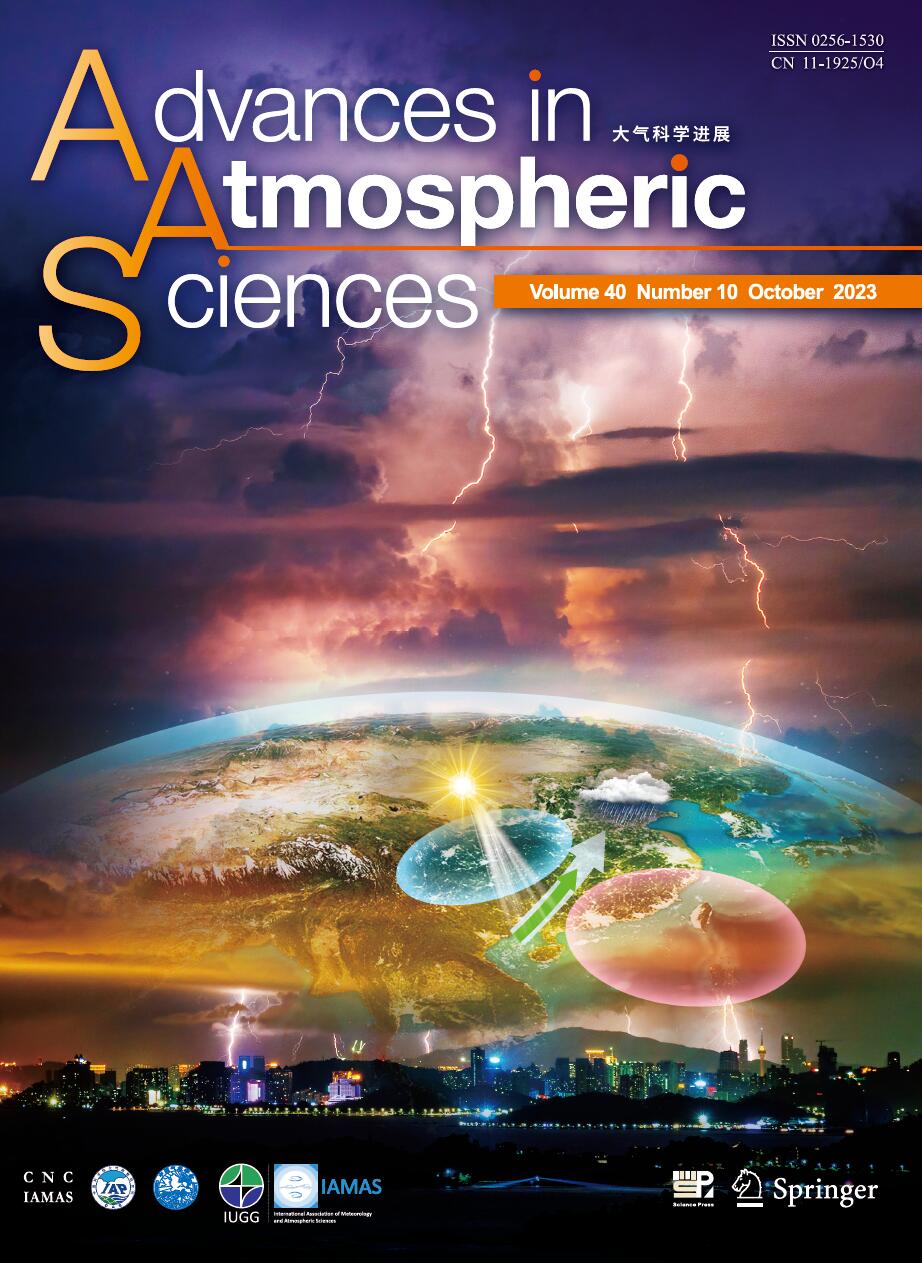| [1] |
FU Danhong, GUO Xueliang,
2006: A Cloud-resolving Study on the Role of Cumulus Merger in MCS with Heavy Precipitation, ADVANCES IN ATMOSPHERIC SCIENCES, 23, 857-868.
doi: 10.1007/s00376-006-0857-9
|
| [2] |
GAO Shanhong, LIN Hang, SHEN Biao, FU Gang,
2007: A Heavy Sea Fog Event over the Yellow Sea in March 2005: Analysis and Numerical Modeling, ADVANCES IN ATMOSPHERIC SCIENCES, 24, 65-81.
doi: 10.1007/s00376-007-0065-2
|
| [3] |
ZHOU Yang, JIANG Jing, Youyu LU, and HUANG Anning,
2013: Revealing the effects of the El Nio-Southern oscillation on tropical cyclone intensity over the western North Pacific from a model sensitivity study, ADVANCES IN ATMOSPHERIC SCIENCES, 30, 1117-1128.
doi: 10.1007/s00376-012-2109-5
|
| [4] |
LIN Wenshi, Cholaw BUEH,
2006: The Cloud Processes of a Simulated Moderate Snowfall Event in North China, ADVANCES IN ATMOSPHERIC SCIENCES, 23, 235-242.
doi: 10.1007/s00376-006-0235-7
|
| [5] |
GAO Yanhong, Yongkang XUE, PENG Wen, Hyun-Suk KANG, Duane WALISER,
2011: Assessment of Dynamic Downscaling of the Extreme Rainfall over East Asia Using a Regional Climate Model, ADVANCES IN ATMOSPHERIC SCIENCES, 28, 1077-1098.
doi: 10.1007/s00376-010-0039-7
|
| [6] |
Xiao Qingnong, Guo Weidong, Zhou Xiaoping,
1996: Preliminary Results from Numerical Experiments of a Heavy Rain Process with PENN STATE / NCAR MM5, ADVANCES IN ATMOSPHERIC SCIENCES, 13, 539-547.
doi: 10.1007/BF03342044
|
| [7] |
MA Yan, CHEN Shang,
2007: Validation of the Polar MM5 for Use in the Simulation of the Arctic River Basins, ADVANCES IN ATMOSPHERIC SCIENCES, 24, 863-874.
doi: 10.1007/s00376-007-0863-6
|
| [8] |
Xiangzhou SONG, Dexing WU, Xiaohui XIE,
2019: Tides and Turbulent Mixing in the North of Taiwan Island, ADVANCES IN ATMOSPHERIC SCIENCES, 36, 313-325.
doi: 10.1007/s00376-018-8098-2
|
| [9] |
XU Zhifang, GE Wenzhong, DANG Renqing, Toshio IGUCHI, Takao TAKADA,
2003: Application of TRMM/PR Data for Numerical Simulations with Mesoscale Model MM5, ADVANCES IN ATMOSPHERIC SCIENCES, 20, 185-193.
doi: 10.1007/s00376-003-0003-x
|
| [10] |
Fei WANG, Lifang SHENG, Xiadong AN, Haixia ZHOU, Yingying ZHANG, Xiaodong LI, Yigeng DING, Jing YANG,
2022: The Impact of an Abnormal Zonal Vertical Circulation in Autumn of Super El Niño Years on Non-tropical-cyclone Heavy Rainfall over Hainan Island, ADVANCES IN ATMOSPHERIC SCIENCES, 39, 1914-1924.
doi: 10.1007/s00376-022-1388-8
|
| [11] |
TSAI Li-Min, LIU Koung-Ying, WANG Zifa,
2011: Taiwan Yushan Snowfall Activity and Its Association with Atmospheric Circulation from 1979 to 2009, ADVANCES IN ATMOSPHERIC SCIENCES, 28, 1423-1432.
doi: 10.1007/s00376-011-0178-5
|
| [12] |
Gong-Wang Si, Kuranoshin Kato, Takao Takeda,
1995: The Early Summer Seasonal Change of Large-scale Circulation over East Asia and Its Relation to Change of The Frontal Features and Frontal Rainfall Environment During 1991 Summer, ADVANCES IN ATMOSPHERIC SCIENCES, 12, 151-176.
doi: 10.1007/BF02656829
|
| [13] |
Guidi ZHOU, Xuhua CHENG,
2022: Impacts of Oceanic Fronts and Eddies in the Kuroshio-Oyashio Extension Region on the Atmospheric General Circulation and Storm Track, ADVANCES IN ATMOSPHERIC SCIENCES, 39, 22-54.
doi: 10.1007/s00376-021-0408-4
|
| [14] |
Minghao YANG, Chongyin LI, Xin LI, Xiong CHEN, Lifeng LI,
2022: The Linkage between Midwinter Suppression of the North Pacific Storm Track and Atmospheric Circulation Features in the Northern Hemisphere, ADVANCES IN ATMOSPHERIC SCIENCES, 39, 502-518.
doi: 10.1007/s00376-021-1145-4
|
| [15] |
Wang Zuoshu, Zhang Ruojun, Peng Zhengyi,
1989: The Kinetic Energy Budget and Circulation Characteristics of the Tropical Storm Irma during AMEX Phase II, ADVANCES IN ATMOSPHERIC SCIENCES, 6, 414-423.
doi: 10.1007/BF02659076
|
| [16] |
QIAN Yu-Kun, LIANG Chang-Xia, LIANG Qiaoqian, LIN Liangxun, YUAN Zhuojian,
2011: On the Forced Tangentially-Averaged Radial-Vertical Circulation within Vortices. Part II: The Transformation of Tropical Storm Haima (2004), ADVANCES IN ATMOSPHERIC SCIENCES, 28, 1143-1158.
doi: 10.1007/s00376-010-0060-x
|
| [17] |
Xiao Qingnong, Wu Rongsheng,
1995: A Study on Frontal Motion over Orography, ADVANCES IN ATMOSPHERIC SCIENCES, 12, 325-334.
doi: 10.1007/BF02656981
|
| [18] |
HU Yongyun, TAO Lijun, and LIU Jiping,
2013: Poleward Expansion of the Hadley Circulation in CMIP5 Simulations, ADVANCES IN ATMOSPHERIC SCIENCES, 30, 790-795.
doi: 10.1007/s00376-012-2187-4
|
| [19] |
FENG Juan, LI Jianping, ZHU Jianlei, LI Fei, SUN Cheng,
2015: Simulation of the Equatorially Asymmetric Mode of the Hadley Circulation in CMIP5 Models, ADVANCES IN ATMOSPHERIC SCIENCES, 32, 1129-1142.
doi: 10.1007/s00376-015-4157-0
|
| [20] |
Yuanhai FU, Riyu LU, Dong GUO,
2021: Projected Increase in Probability of East Asian Heavy Rainy Summer in the 21st Century by CMIP5 Models, ADVANCES IN ATMOSPHERIC SCIENCES, 38, 1635-1650.
doi: 10.1007/s00376-021-0347-0
|















 AAS Website
AAS Website 
 AAS WeChat
AAS WeChat 
 DownLoad:
DownLoad: